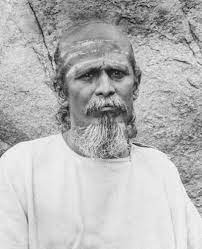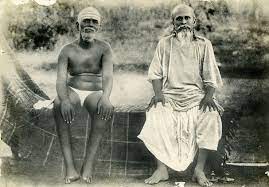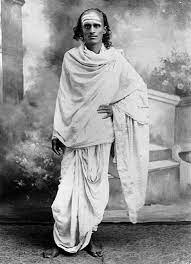Ganapati Muni’s story is beautifully depicted in his biography, Vashishtha Vaibhavam, composed by Shri Kapali Shastri. Ganapati Muni was educated at home by his father, who, like his ancestors, was well versed in Mantra Shastra, Astrology and Ayurveda. It is said that he could prepare a panchangam (almanac) at the tender age of ten.
After studying classical Sanskrit poems, he devoted himself to the study of grammar and poetics. He completely immersed himself into the writings of Vyasa and Valmiki and read their works repetitively. This gained him great expertise in the study of the Mahabharata.
His horizon widened and his intellect mellowed with an ever-deepening perception. He was married at an early age to Srimati Vishalakshi, but this did not stop him from pursuing his spiritual and scholarly expedition. Like the ancient Rishis, Ganapati wanted to experience immense strength and power by the practice of tapasya through mantra japa and meditation.
He used to visit one sacred place after another, and stayed there for a few days or even months, to pursue his tapasya even when he was just 18 years of age.
On one such visit to Bhubaneswar, in Orissa, at the famous “Lingaraj” temple of Lord Siva, during his tapas, the Muni had a vision, in which Goddess Lalitambika (Bhubaneshwari) appeared before him, offering divine nectar. As Ganapati tasted this heavenly nectar, the Goddess watched him with a sweet smile, full of grace. From then onwards, the sweetness of the nectar became an integral part of him. After this incident, Ganapati’s intellect developed a rare sharpness and he attained complete mastery over poetry. Indeed, the literary works composed after this incident are endowed with a distinct sweetness and grace.
It was in Kashi that Ganapati came to know that an assembly of scholars (harisabha) is going to be organised in the city of Nabadwipa in Bengal. The assembly was meant for scholars to showcase their scholarship. Ganapati’s friends advised him to obtain a letter of introduction and participate in the assembly. The twenty-two years old Muni attended the assembly and proved himself to be the best among them. Because of this, he was honoured with the title of ‘Kavyakanth’ by the eminent scholars who attended the harisabha. Kavyakanth can be translated as the one who has a poetic voice.
The Muni then returned to the south in his 25th year. From Kanchipuram he came to Arunachala (Thiruvannamalai) in 1903 to perform tapas. He visited Sri Brahmana Swamy twice before he accepted a teaching job at Vellore in 1904. Later in 1907, he resigned his job at Vellore and returned to Arunachala. The Muni still felt that his life’s purpose was not fulfilled and he approached Brahmana Swamy for his grace and to gain inner realization, peace and the true import of tapas that he still lacked. On 18th February 1907 the Muni approached Brahmana
Swamy, who was staying in the Virupaksha cave, and prostrating himself at his feet, prayed to enlighten him about the nature of tapas.For quite sometime Brahmana Swamy gazed silently at Kavyakantha. Then he broke his 11 years of long silence and spoke gently, “If one watches where his notion of “I” springs, the mind will be absorbed into that. That is tapas. If a mantra is repeated and attention is directed to the source where the mantra sound is produced, the he mind will be absorbed in that. That is tapas.” The Muni was filled with joy to have found his guru. He conferred the full name of Bhagavan Sri Ramana Maharshi to Brahmana Swamy, whose original name was Venkataraman. Thus, the meeting was of profound significance not only for Kavyakantha but also for the world at large, which could learn from such a high authority about the real stature of Bhagavan Sri Ramana Maharshi, the Silent Sage of Arunachala. Following this momentous meeting, Ganapati composed his great devotional poem, Umasahasram, a thousand verses in praise of Uma, the Divine Mother, as a part of his tapas in gratitude to the great Goddess for having given him the Maharshi as his Guru (Master). This work is the magnum opus of Sri Vasishtha Ganapati Muni.
Ganapati Muni passed away in 1936 leaving behind a remarkable legacy for us to cherish and propagate. Vasishtha Kavyakantha Ganapati Muni was equipped with such unique scholarship and ability to express that he could write or speak elaborately on any topic with apparent ease. Therefore, his writings cover a wide range of topics, including spirituality, cosmology, metaphysics, science, poetry, linguistics, etc. He composed poetry, sutras, wrote commentaries, and penned novels, articulating his views on many serious topics with force, intensity, fluency, lucidity and loftiness.
In addition to he being a poet, patriot, yogi, Tantrik, a Rishi with right vision, the Muni was an excellent avadhani. He was in possession of an exceptional retentive memory, a great power of concentration, ability to compose unblemished extempore poetry, spontaneous creativity, imagination, poetic ability and quick thinking, and all these add a lot to his consummate scholarship and literary genius.



